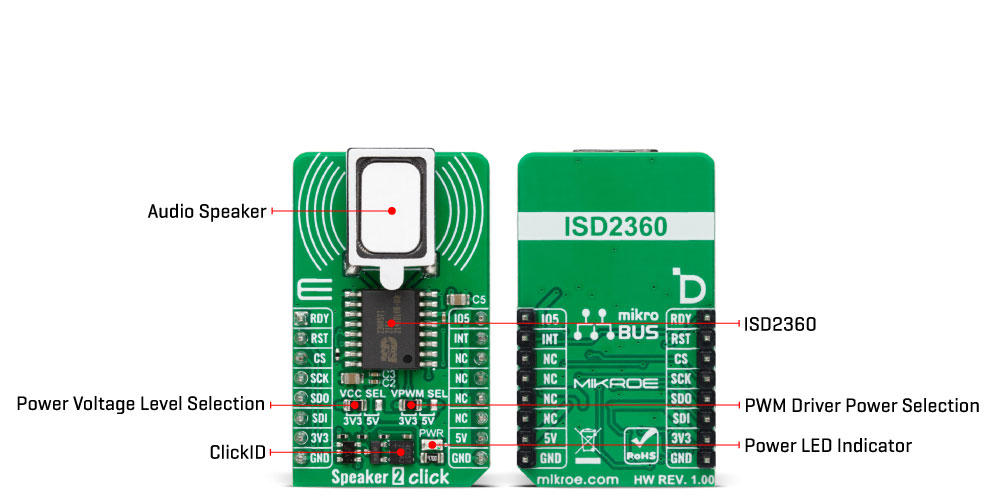OFF
GO LOCAL
| Company | Stock | Price |
|---|---|---|

MIKROE-6515
19 g
Status:
Speaker 2 Click is a compact add-on board for high-quality audio playback and voice prompt applications. This board features the ISD2360, a 3-channel digital ChipCorder® from Nuvoton, which integrates flash memory for non-volatile audio storage and playback. The ISD2360 supports up to 64 seconds of audio storage with digital decompression, independent multi-channel playback, and a Class D speaker driver for driving the onboard AS01508AO-SC-R speaker. It features a standard SPI interface, configurable I/O pins, and built-in program verification, ensuring reliable operation with minimal external components. The board also includes selectable logic voltage levels (3.3V or 5V) and a jumper for independent digital power selection. Speaker 2 Click is ideal for embedded applications requiring clear voice prompts, sound effects, or pre-recorded messages, making it suitable for automation systems, consumer electronics, and industrial devices.
Speaker 2 Click is fully compatible with the mikroBUS™ socket and can be used on any host system supporting the mikroBUS™ standard. It comes with the mikroSDK open-source libraries, offering unparalleled flexibility for evaluation and customization. What sets this Click board™ apart is the groundbreaking ClickID feature, enabling your host system to seamlessly and automatically detect and identify this add-on board.
This product is no longer in stock
Availability date:
OFF
| Company | Stock | Price |
|---|---|---|

Speaker 2 Click is based on the ISD2360, a 3-channel digital ChipCorder® from Nuvoton, designed to store and play high-quality audio using integrated flash memory. This Click board™ provides a way to manage and deliver voice prompts, sound effects, or pre-recorded audio messages, making it ideal for applications that require embedded audio playback without the complexity of external components. The ISD2360 features digital decompression, comprehensive memory management, and a fully integrated audio signal path, allowing it to handle up to three concurrent audio streams. Each playback channel operates independently, enabling precise micro-management of voice macro execution, particularly useful for complex audio sequences.

With built-in flash memory, the ISD2360 provides non-volatile storage for audio playback, supporting up to 64 seconds of audio based on an 8kHz/4-bit ADPCM compression format. This eliminates the need for external memory solutions while ensuring efficient storage and high-quality audio reproduction. The device simplifies audio management by offering a straightforward method for storing pre-recorded voice prompts, using an index-based command system that does not require manual address configuration. Additionally, executing pre-programmed macro scripts (Voice Macros) enhances flexibility in controlling playback sequences and system behavior.
One of the standout features of this Click board™ is its integrated Class D speaker driver, which is optimized for driving the onboard speaker, the AS01508AO-SC-R. This allows for clear audio output without requiring additional amplification stages. The ISD2360 is designed to function without external clock sources or supplementary components. Furthermore, it includes built-in non-volatile flash storage in 1Kbyte sectors, eliminating the need for separate EEPROM or flash memory devices for storing configuration data and audio files.
The ISD2360 supports various sampling frequencies, delivering excellent signal-to-noise ratio (SNR) performance while maintaining low power consumption. The fast programming time ensures quick audio storage, while the integrated program verification feature guarantees the reliability of recorded content.
Speaker 2 Click communicates with the host MCU using a standard SPI interface and several other pins, which are also multiplexed with six general-purpose I/O pins, providing additional flexibility in system integration. The ISD2360 is configured by writing to dedicated configuration registers, which can be done by directly sending configuration commands over the SPI interface or executing pre-programmed Voice Macros containing configuration instructions. In addition to standard interface and control pins, the board includes several auxiliary pins that enhance its functionality.
The RDY pin serves as an output to indicate the status of data transfer on the SPI bus, where a HIGH signal means the ISD2360 is ready to receive new SPI commands or data; alternatively, it can function as a general-purpose I/O pin. The INT pin is an active-low interrupt request signal that alerts the MCU to specific events and can also be repurposed as a general-purpose I/O. Additionally, the IO5 pin provides an extra general-purpose I/O option, further expanding the board's customization potential.
This Click board™ can operate with either 3.3V or 5V logic voltage levels selected via the VCC SEL jumper. This way, both 3.3V and 5V capable MCUs can use the communication lines properly. Additionally, the board features a VPWM SEL jumper, which allows for selecting the digital power supply for the PWM driver of the ISD2360 independently from the logic power supply of the Click board™ itself. This ensures greater flexibility in power management, enabling the user to optimize the board's operation based on the application's specific requirements. Also, this Click board™ comes equipped with a library containing easy-to-use functions and an example code that can be used as a reference for further development.
Type
Speakers
Applications
Ideal for embedded applications requiring clear voice prompts, sound effects, or pre-recorded messages for automation systems, consumer electronics, and industrial devices
On-board modules
ISD2360 - 3-channel digital ChipCorder® IC with built-in flash storage from Nuvoton
Key Features
High-quality audio playback for voice prompts and sound effects, up to 64 seconds of non-volatile audio playback, supports up to three concurrent audio streams with independent control, onboard AS01508AO-SC-R speaker, SPI interface, configurable I/O pins, independent digital power selection, pre-programmed voice macros support, and more
Interface
GPIO,SPI
Feature
ClickID
Compatibility
mikroBUS™
Click board size
M (42.9 x 25.4 mm)
Input Voltage
3.3V or 5V
This table shows how the pinout on Speaker 2 Click corresponds to the pinout on the mikroBUS™ socket (the latter shown in the two middle columns).
| Label | Name | Default | Description |
|---|---|---|---|
| LD1 | PWR | - | Power LED Indicator |
| JP1 | VCC SEL | Left | Power Voltage Level Selection 3V3/5V: Left position 3V3, Right position 5V |
| JP2 | VPWM SEL | Left | PWM Driver Power Selection 3V3/5V: Left position 3V3, Right position 5V |
| Description | Min | Typ | Max | Unit |
|---|---|---|---|---|
| Supply Voltage | 3.3 | - | 5 | V |
| Playback Duration | - | - | 64 | sec |
| Sampling Frequency | 4 | - | 32 | kHz |
Speaker 2 Click demo application is developed using the NECTO Studio, ensuring compatibility with mikroSDK's open-source libraries and tools. Designed for plug-and-play implementation and testing, the demo is fully compatible with all development, starter, and mikromedia boards featuring a mikroBUS™ socket.
Example Description
This example demonstrates the use of the Speaker 2 Click board. It initializes the board and plays predefined voice messages or sound effects through the speaker module. Supported voices include numbers (ONE to SIX) and sound effects like FAST BEEP.
Key Functions
speaker2_cfg_setup Config Object Initialization function.speaker2_init Initialization function.speaker2_default_cfg Click Default Configuration function.speaker2_play_voice This function plays a voice at the specified index.speaker2_play_macro This function executes a macro command at the specified index.speaker2_play_voice_loop This function plays a voice in a loop for a specified number of iterations.Application Init
Initializes the logger module, configures the Speaker 2 Click board, and applies the default settings to reset the device, power it up, verify communication, and load an example audio project into the device memory.
Application Task
Sequentially plays predefined voice messages and sound effects from the Speaker 2 Click board while logging the playback status (DONE or ERROR) for each sound.
Application Output
This Click board can be interfaced and monitored in two ways:
Additional Notes and Information
The complete application code and a ready-to-use project are available through the NECTO Studio Package Manager for direct installation in the NECTO Studio. The application code can also be found on the MIKROE GitHub account.
NOTE: Please be advised that any peripheral devices or accessories shown connected to the Click board™ are not included in the package. Check their availability in our shop or in the YMAN section below.